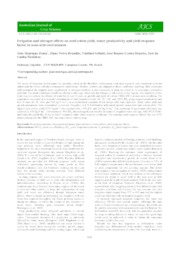Irrigation and nitrogen effects on seed cotton yield, water productivity and yield response factor in semi-arid environmernt.
Irrigation and nitrogen effects on seed cotton yield, water productivity and yield response factor in semi-arid environmernt.
Author(s): ZONTA, J. H.; BRANDAO, Z. N.; SOFIATTI, V.; BEZERRA, J. R. C.; MEDEIROS, J. da C.
Summary: The study of irrigation technologies for growing cotton in the Brazilian northeastern semi-arid region is very important to better understand the water-soil-plant-atmosphere interactions. Modern varieties are adapted to these conditions, reaching their maximum yield potential. In irrigated areas, application of nitrogen fertilizer is also necessary to keep up cotton to its maximum productive potential. The ideal conditions should be offered to the crop, where this knowledge is still scarce in this region. The objective of this work was to evaluate the effects of water levels and N rates on growth and yield of cotton (‘BRS 286’) in semi-arid condition. The experiment consisted of a factorial combination of four irrigation levels [40, 70, 100, and 130% ETc (crop evapotranspiration)] and four N rates (0, 70, 140, and 210 kg N ha-1), in a randomized complete block design with four replicates. Seed cotton yield and growth parameters were determined at harvest. Irrigation and N fertilization influenced growth parameters and cotton yield. The highest seed cotton yield (5707 kg ha-1) was reached with 130% ETc and 210 kg N ha-1. The maximum N agronomic efficiency was achieved at 140 kg N ha-1. The treatment 70% ETc showed significant benefits in terms of irrigation water savings, with WUE 0.587, indicating the possibility of use to deficit irrigation under water scarcity conditions. The seasonal yield response factor (Ky) was 0.70, demonstrating that the ‘BRS 286’ was water stress-tolerant crop.
Publication year: 2016
Types of publication: Journal article
Unit: Embrapa Cotton
Observation
Some of Embrapa's publications are published as ePub files. To read them, use or download one of the following free software options to your computer or mobile device. Android: Google Play Books; IOS: iBooks; Windows and Linux: Calibre.
Access other publications
Access the Agricultural Research Database (BDPA) to consult Embrapa's full library collection and records.
Visit Embrapa Bookstore to purchase books and other publications sold by Embrapa.

